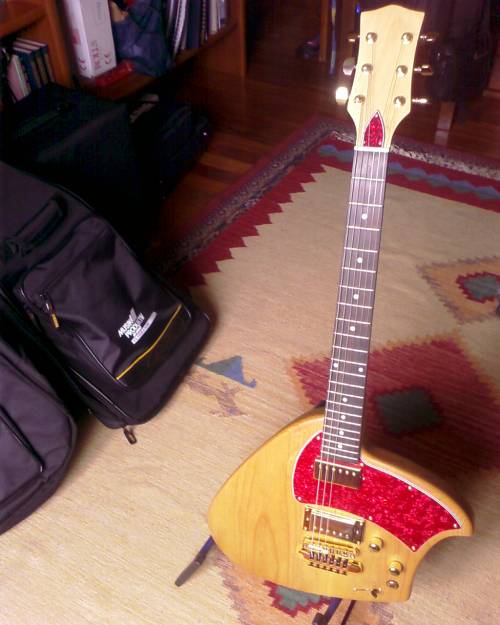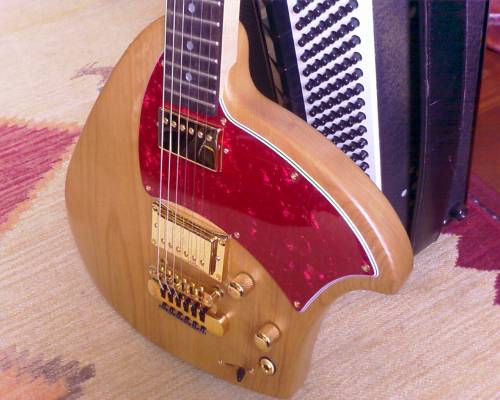Short Scale Klein Style Electric Guitar
Josemi and his friend Joserra build a Klein style electric guitar that mates the body to a 24 3/4″ short scale neck with headstock and conventional bridge and tuners. Let’s take a look.

A Short Scale Neck Meets a Klein-style Guitar Body
Using an image of the wider Klein harp guitar as a starting point, the two created a styrofoam template and then removed material from the upper bout until it was “more natural and pleasant” to play with a “straight back and balanced shoulders.”
The short scale neck is thinner than a Les Paul’s and Josemi states that upper fret “access is easier than in any other guitar i have ever tried.” However, he’ll be reshaping the heel further to gain even better access to the higher frets. Then he’ll finish the neck in a glossy varnish.
Bridge and tuning hardware is handled by a Tune-o-matic bridge, a Schaller Fine-tuning Tailpiece and Wilkinson EZ-Lock tuners.
I was curious how the addition of a headstock would impact the Klein based design and Josemi felt “the instrument’s balance is good playing sitting and standing” despite the headstock. He felt the combination of the neck’s short scale, heavy hardware and pickups helped offset the headstock.
The resulting guitar weighs 3 kg or 6.6 lb. By comparison an American Standard Strat he owns weighs roughly 3.5 kg or 7.7 lb. Overall its a nice weight savings.

Electronics and Wiring
Josemi used the now discontinued Tonerider Alnico2 vintage spec pickups which he considers “incredible pickups. I have them installed on other guitars, and always get incredible tone and dynamics.” These particular pickups have four conductors and are wired with an EYB “type E” switch resulting in the following combinations:
- 1 – neck humbucker
- 2-neck single
- 3- bridge + neck single
- 4-bridge single
- 5-bridge humbucker
How does it sound?
Outfitted with a Pyramid nickel .011 string set and intended primarily for jazz, Josemi describes the alder body electric guitar’s sound as follows:
“very rounded: no booming bass, very defined mids and silky soft like butter highs. All positions are usable, pleasant and balanced. Position one gives a jazzy horn-like tone that everybody who hears falls in love with instantly.
I’m very very pleased with its feel and tone, very easy to play. I’m so satisfied with it, that I just don’t want to play my other guitars (guess they are jealous now ha ha!)
Joserra is also working on another guitar build with a different shape, neck, hardware and pickups. I’m looking forward to it.
Aside from being very attractive, this is an interesting build because it discards the presumption that a Klein shape must have a headless configuration. I am sure that balance is also aided by the larger harp guitar body.
Some weight could be saved by using lighter tuners, a more compact headstock design, and a one piece wraparound bridge like that used by PRS.
A very nice instrument indeed! Nice work guys.
It’s definitely great to see guitar builds taking advantage of conventional parts, necks with headstocks etc. The amount of choice compared to headless parts is tremendous and really opens things up for experimentation.
How short is this short scale? 24.625″? 24″?
Michael – It’s a 24 3/4″ neck. I’ve updated the article as well. Thanks for the catch – I meant to include that.
I like the look of it not having a tuner cutout on the body. It also probably helps some with overall balance.
It looks like he used a salvaged neck, so the headstock shape was pretty well set, but you could buy a “paddle head” neck from Warmoth and cut a much more compact headstock to further improve the guitar’s looks (imho) and balance. (assuming the balance could be improved)
It’s a neck from eBay.
Very nice build! I was just about to get back to working on mine,also a short scale neck, when work got in the way. Sigh, maybe next week. Yours is a beautiful guitar.
Looking forward to seeing your project, Don.
Hey, that’s a neat one! The general finish and configuration is very Kleinish by and large, but those guitars with a headstock on becomes – inevitably – just an Ovation Deacon or Breadwinner copy instead.
One thing I find very peculiar though. If you placed the p-u switch far back almost along with the output jack, what’s the point of having that large pickguard then? That stretches down to the front just like on a Klein. Since it doesn’t cover up anything but beautiful wood that would be more suitable to be visible? There’s no controls at all, or switches underneat the pickguard so I find that very peculiar having to waste that much space for a plastic pickguard, when the wood would be much more nicer to look at. Also, one does not really pick in that direction, so far down, so it won’t provide any guard against pick scratches anyway.
Also, I like guitars to “end” where the strings ends. I would’ve place the bridge as far back on the body as possible, with no excessive wood behind it. Especially to counterbalance the headstock weight. But I bet it doesn’t “wiggle” and bounce around as almost every headless does, when playing.
But who am I to speak, in the middle of assembling a pure traditional Stratocaster right now with parts from USACG, with nothing new or ergonomic to it, at all. It’s sooo vintage, traditional and boring. I may be expelled from this forum confessing it… 🙂
Mats, 23 of my 25 guitars are decidedly un-ergonomic and mostly traditional. I discovered the joys of ergo rather late in the acquisition game… Playing catch-up now. 🙂
Playing catch up and doing a very nice job of it. 🙂
“just an Ovation Deacon or Breadwinner copy”
Why “just”? You say that like it’s a bad thing.
No, I just thought that it aint really a Klein or Klein copy then. And that it has been done before. A Klein copy with headstock on should be called a Breadwinner/Deacon instead. In spite of that the lower horn is somewhat different on a Klein than on the Ovation.
I tried Ovantions, they don’t neck dive at all, in spite them having headstock. However, the hardware and pikcups on those are not really to my liking that’s all.
They show up on second hand display from time to time.
That’s great Roger, however, I discovered that I really had to have one of these regular types as well. Owning only 2 electrics, one Klein, a Hagstrom jazzbox, and the funny bass I displayed earlier. Oh, I have an acoustic too, a Babicz. But that’s it. Granted, the Klein is my major axe at the moment. I took me 3-4 years before I thought that I needed a complimentary instrument.
Have very little GAS myself. It’s in the DNA. Or something. 🙂
Thank you all for your opinions and ideas.
Yesterday night I peformed live for first time with this guitar and I have to say that the experience was great. Played standing, and felt the balance is good (although the ergonomic design shows up better when sitting).
Listeners liked the guitar’s tone and look.
Yes, maybe later on I’ll try to change the headstock’s shape (trying to match the body’s upper curve) and lighter machineheads (steinberger gearless), to improve weight balance, but for now I’m really happy with it.
In fact, what I pursued with this guitar is not copying a particular look (klein, ovation, etc) but ergonomics and tone, and definitely I believe that it exceedes my expectations.
Talking about the pickguard (Mats): yes, we placed the switch near the output jack in order to rout less wood and simplify. Anyway I liked the klein’s pickguard look, and definitely the pickguard gives the guitar a much more classy look and visual balance. Also it serves for the purpose of holding the neck pickup.
Ok Josemi, now I got an explanation. Most people, doing their Klein replicas, actually dislikes the pickguard, and seems to be the only thing that they dislike about the Klein.
Refreshing to hear at least one opposite opinion for once! 🙂
Personally, I am inclined towards, the more wood and less plastic, the better. Some uses see through or transparent plastic. Of course, if your body had routes in it before, you must cover them up anyway with a pickguard. As for visual balance? Well, each to their own, of course.
Generally agreed – I’m not a particular of pickguards and left it off my project as well. But I do know at least one guitar guy around here who swears by them. 😉 Nonetheless, it’s a lovely job.
no Mats, the guitar had no routes in it before.
Yes, each to their own, and for me the pickguard just gives the guitar a more sophisticated, pleasant, relaxed, equilibrated (balanced) look. Thats all.